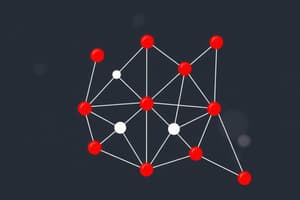Podcast
Questions and Answers
What is the purpose of the path.unshift(current + 1) statement in the given code?
What is the purpose of the path.unshift(current + 1) statement in the given code?
- To convert the current node index to a string.
- To eliminate the last element of the path array.
- To prepend the current node's index to the path array. (correct)
- To add the current node to the end of the path array.
What would happen if you replaced previous[current] with next[current] in the while loop?
What would happen if you replaced previous[current] with next[current] in the while loop?
- It would still correctly reconstruct the path.
- It would cause an error due to an undefined variable.
- It would access the next node instead of the previous one. (correct)
- It would lead to an infinite loop.
In the context of this code, what does end represent?
In the context of this code, what does end represent?
- The start node of the path.
- A variable managing the total number of iterations.
- A constant that defines the maximum number of nodes.
- The index of the final node in the path. (correct)
What is the significance of the return path.join('-'); statement in the code?
What is the significance of the return path.join('-'); statement in the code?
What is the initial value of current set to in the path reconstruction process?
What is the initial value of current set to in the path reconstruction process?
Flashcards are hidden until you start studying
Study Notes
Reconstructing the Path
- The code snippet reconstructs the shortest path found using Dijkstra's algorithm.
- The
patharray will store the nodes in the path. currentis initialized to theendnode.- It iterates through the nodes in reverse order using a
whileloop until it reaches the starting node. - In each iteration, the current node's index is added to the beginning of the
patharray usingunshift. - The
previousarray stores the predecessor of each node in the shortest path. - The
currentnode is then set to its predecessor from thepreviousarray. - The code then joins the nodes in the
patharray using a-delimiter to form the final path string. - This functionality allows the code to determine and display the shortest path between two nodes in a graph based on Dijkstra's algorithm.
Studying That Suits You
Use AI to generate personalized quizzes and flashcards to suit your learning preferences.



